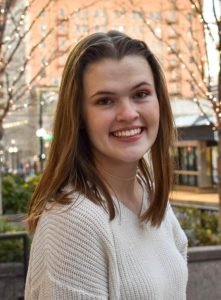U Origins: A Clearer Picture of Philanthropy at the U and How it Has Shaped Campus
The UTA TRAX Red Line passing in front of the Rice-Eccles Stadium in Salt Lake City, Tuesday, Feb. 21, 2023. (Photo by Marco Lozzi | The Daily Utah Chronicle)
February 23, 2023
An invisible trail exists on the University of Utah campus. It won’t appear on any campus map, despite being traveled by thousands of students each week. This urban trail is what many students walk to get to class from the train.
Some students like Muwaffaq Usman Adam, an international graduate student from Ghana, walk miles to reach their first class, but with high parking pass prices, walking remains the closest and most economical option.
“The temperature has been super unfriendly, so I have opted to use the buses [the] majority of the time,” Adam said.
The trail begins at the University South Campus Station of the Red Line train, crosses the parking lot of the University Services Building, then passes the building’s loading dock, dodging Buildings and Grounds Crew vehicles before sneaking behind the central parking garage. Finally, the trail ends at a building where classes are held. Students hike half a mile to get from the station to the library and more than six-tenths of a mile to reach the A. Ray Olpin Student Union Building.
Several factors have influenced the design of U campus transportation, including well-known philanthropist Spencer F. Eccles, donations from the Church of Jesus Christ of Latter-day Saints and the 2002 Winter Olympics.
The origins of why the Red Line, or “University Line,” swerves around campus rather than leading to its center, raises questions surrounding a network of prominent organizations and philanthropists’ involvement in campus design dating back to the mid-1990s, before the line existed and before so many buildings on campus displayed the “Eccles” name.

Funding the Red Line Extension
According to the Utah Transit Authority, about 40% of students, faculty and staff use public transit at the U.
“Building the line on the campus was a game changer,” said manager of project research and development for UTA, Hal Johnson. Johnson was assigned as a transit planner of the Red Line extension for UTA during the time of TRAX expansion.
By August 2000, construction had begun on the University Line which extended TRAX from downtown to Rice-Eccles stadium in preparation for the Olympic games, which were set to begin in February 2002.
Just one month before the Olympics began, UTA signed a joint agreement worth roughly $89.3 million with the U to create a hospital extension of TRAX that would connect the University hospital to Rice-Eccles Stadium, adding three more stops.
“We executed a second grant agreement with the Federal Transit Administration to fund that extension,” Johnson said.
While the FTA grant did not fund the entire project, it did provide a matching system where UTA had to match the donation given by the federal government in order to qualify for the grant. According to the grant agreement, $2.97 million was allotted by the FTA, while UTA was required to raise $1.98 million in local match.
UTA found its primary source of funding from an added sales tax and two notable private donations.
“For funding … we actually got a donation from the LDS Church,” Johnson said.
At the time, The Church of Jesus Christ of Latter-day Saints was constructing the institute building that now sits only a few feet away from the South Campus Station. The deal involved allotting parking space to the U from the Institute of Religion’s parking garage, Johnson said.
“We really wanted to put the [South Campus] station by the library,” Johnson said.
Despite the line itself passing only 500 feet from the doorstep of the library, Johnson cited geography and width of roads as reasons why the station wasn’t built by the J. Willard Marriott Library.
Adam, a masters student of City and Metropolitan Planning, said, “I think there should be a TRAX station just after the stadium. South campus [station] is pretty far for students whose colleges and classes are around the Marriott Library.”
Johnson said UTA agreed to move the station away from the library based on the thinking that the U would redevelop the utility buildings that now surround the South Campus TRAX station into classroom space.
“Hopefully over time that’ll continue to redevelop,” Johnson said.
Campus redevelopment surrounding both the Rice-Eccles and the South Campus TRAX stations has been limited to the new S.J. Quinney College of Law.
According to Johnson, the second private donation used to match the FTA grant was a donation from the George S. and Dolores Doré Eccles Foundation to construct the well-known Legacy Bridge that stretches over Mario Capecchi Drive. According to a report done by the Structural Engineering International, the bridge was completed in December 2001.
Toni Lehtinen, who has served as director of communications and grants management at the George S. and Dolores Dore Eccles Foundation for more than 15 years, said that the foundation had nothing to do with the TRAX line extension. Lehtinen cited the timeline difference of the line’s construction with the building of the bridge, saying, “The TRAX line came around much later.”
According to railways.net, by April of 2001, design had already begun on the 1.5-mile TRAX extension of the University line from Rice-Eccles Stadium to the University Medical Center, months before construction of the Legacy Bridge was completed.
The bridge connects to Fort Douglas, the third of the hospital extension stations. Fort Douglas would serve as housing for Olympians during the 2002 Winter games.
“The [Fort Douglas] station on Mario Capecchi was really designed to serve the student housing … as well as the Huntsman Center,” Johnson said, adding that the Fort Douglas station would be the second station serving the Huntsman Center.
According to Lehtinen, the bridge was intended to be of long-term benefit to the University.
“It had two benefits … student housing, [and] also to the athlete village,” Lehtinen said. “That related to the foundation’s generous support to the university.”
Though UTA records do not explicitly attribute the donations to neither the Eccles Foundation nor The Church of Jesus Christ of Latter-day Saints, for the hospital extension, two major private donations are found in the FTA’s grant agreement listed as “pedestrian bridge” and “parking spaces.”

Rice-Eccles Stadium and the 2002 Winter Olympics
The Eccles family’s history of philanthropy at the U predates the building of the Red Line.
Spencer F. Eccles was a member of the Salt Lake Organizing Committee, which ultimately landed the Olympic bid for Salt Lake City to host the 2002 winter games, despite their controversial methods.
By June 1995, Salt Lake City had received the bid from the IOC and with it, the need for infrastructure to host an international event.
With the help of a $10 million dollar donation from the George S. and Dolores Doré Eccles Foundation, construction was completed on Rice-Eccles stadium on Sept. 12, 1998, where opening ceremonies would later be held.
To kickoff opening ceremonies, Spencer F. Eccles lit the Olympic Cauldron and was appointed mayor of the 2002 Athlete Olympic Village, receiving the IOC’s highest honor: the Pierre de Coubertin Medal.
Spencer P. Eccles, son of Spencer F. Eccles, was later selected by the SLOC to oversee and develop a large portion of Olympic events and infrastructure.
Investigations show that beginning in 1998, members of the SLOC extended gifts and special favors to members of the International Olympic Committee in exchange for the 2002 Olympic bid.
The investigation into the bid committee’s tactics became widely known as the Olympic bribery scandal and resulted in criminal charges against two SLOC leaders. Eccles would be a key defense witness when the case went to trial years later.
At first, Eccles publicly condemned the scandal. “[SLOC leaders] succumbed to the siren song of corruption where the end seemed to justify the means,” Eccles told Deseret News reporter Kirsten Sorenson. He continued, saying, “They have failed us.”
On Dec. 1, 2003, Spencer F. Eccles appeared in court as a witness in the bribery trial against leaders of the SLOC. When asked about special treatment, including giving jobs to relatives of IOC members, Eccles told reporters, “I did not know of it. I would not have authorized it without knowing details.”
Eccles, whose son and daughter had both been selected for leadership positions in the 2002 Winter Olympics, later called the trial “ill-conceived” and said that such acts were, “common and mandatory,” despite condemning the actions only a few years earlier.
Less than a week following Eccles’ testimony in court the case was thrown out.
The Eccles Foundation declined to comment on the case.
Donations to the U Hospital and Beyond
Philanthropy at the U continued after the Olympics. On March 28, 2003, a new critical care wing of the U Hospital opened, called the George S. and Dolores Doré Eccles Critical Care Pavilion, baring a $7 million donation from the Eccles Foundation. More than 2,000 U Hospital employees and community members also made less well-known, but substantial, donations to fund the pavilion.
Only six months later, on Sept. 29, 2003, operation began for the newly completed Red Line TRAX extension, introducing a light rail line leading directly to the new pavilion.
Hope Eccles, daughter of Spencer F. Eccles, currently serves on the U Hospital’s community board of directors.
According to Forbes, the Eccles family has donated over $750 million to many organizations in Utah over the last 50 years. Simultaneously, the family’s foundation reported a rise to almost $502 million in corporate investments in 2019.
Most recent data from the Internal Revenue Service shows the George S. and Dolores Dore Eccles Foundation being valued at over $456 million in total assets. Of that, almost $35,000 went to various organizations within the U throughout 2019.
“There are requirements as to how much our foundation awards,” Lehtinen said.
According to the Eccles Foundation’s website, “Among the greatest priorities for the George S. and Dolores Doré Eccles Foundation is ensuring excellence in higher education throughout the State of Utah.”
Funding for the Eccles Foundation’s donations comes from successful investments of capital from the original founders of the foundation, according to Lehtinen.
“There is a [value] that is invested … [and] it’s been invested well so it continues to generate income,” she said, adding that the generated income is then distributed to charitable causes.
IRS data also shows two major foundation expenditures that are not included in reported donations, both of which circle back to the Eccles name.
The first is a total compensation amount of $2 million to the Cynosure Group listed under “investment services.” The Cynosure Group is an investment firm co-founded by Eccles’ son, Spencer P. Eccles, who currently serves as managing director, and Eccles’ son-in-law, Randal K. Quarles, who currently serves as chairman of the board of directors. Hope Eccles also sits on the firm’s board of advisors.
The second is a compensation entitled “accounting services” of over $431,000 to Wells Fargo Bank where Spencer F. Eccles has served as Chairman Emeritus of the company’s Intermountain Banking Region following a 2000 merger with First Security Banking Corporation. Eccles was named CEO at First Security in 1982 after the passing of his uncle, George Eccles.
Student Outlook
Students have learned to use the long walks on campus to their benefit. Adam, for one, said, “I like to use that period for some personal reflections, listening to podcasts or even making a call with friends and family.”











